Middleton W.M. (ed.) Reference Data for Engineers: Radio, Electronics, Computer and Communications
Подождите немного. Документ загружается.

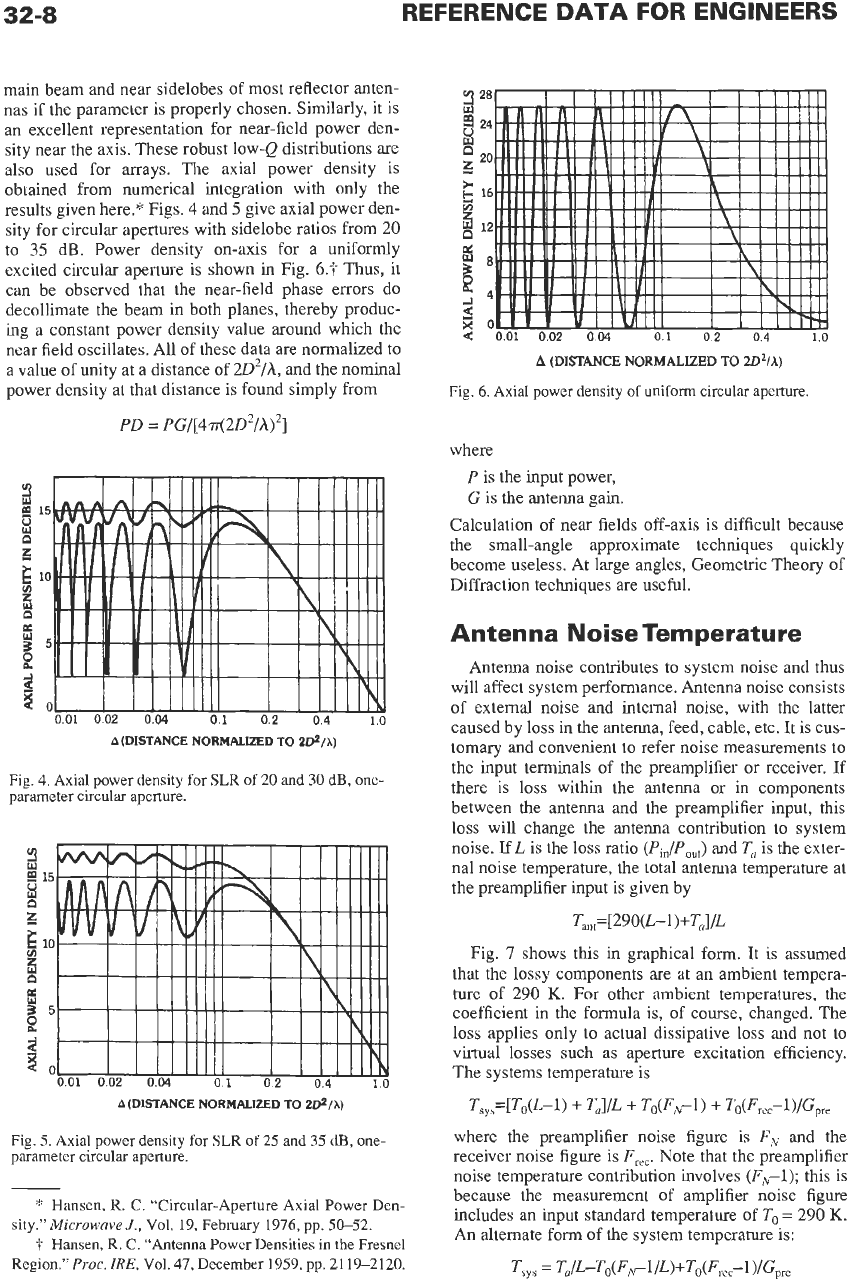
32-8
REFERENCE
DATA
FOR ENGINEERS
main beam and near sidelobes of most reflector anten-
nas if the parameter is properly chosen. Similarly, it is
an excellent representation for near-field power den-
sity near the axis. These robust low-Q distributions
are
also used for arrays. The axial power density is
obtained from numerical integration with only
the
results given here.* Figs.
4
and
5
give axial power den-
sity for circular apertures with sidelobe ratios from
20
to
35
dB. Power density on-axis for a uniformly
excited circular aperture is shown in Fig.
6.1-
Thus, it
can be observed that the near-field phase errors do
decollimate the beam in both planes, thereby produc-
ing a constant power density value around which the
near field oscillates. All of these data
are
normalized to
a value of unity at a distance
of
2D2/h,
and the nominal
power density at that distance is found simply from
PD
=
PG/[~T(~D~/A)~]
0.01
0.02
0.04
0.1
0.2
0.4
1.0
A(D1STANCE NORMALIZED
TO
2#/X)
Fig.
4.
Axial power density for
SLR
of 20 and
30
dB, one-
parameter circular aperture.
A(D1STANCE NORMALIZED
TO
2@/A)
Fig.
5.
Axial power density for SLR
of
25
and
35
dB,
one-
parameter circular aperture.
*
Hansen,
R.
C. “Circular-Aperture Axial Power
Den-
sity.’’
Microwave
J.,
Vol. 19, February 1976, pp. 50-52.
t
Hansen,
R.
C. “Antenna Power Densities in the Fresnel
Region.”Pruc.
IRE,
Vol.
47,
December 1959, pp. 21 19-2120.
2
28
d
24
20
16
M
b
1
12
28
54
Ro
<
04
01
02
04
10
A
(DISTANCE
NORMALIZED
TO
2DZlh)
Fig.
6.
Axial power density of uniform circular aperture.
where
P
is the input power,
G
is the antenna gain.
Calculation of near fields off-axis is difficult because
the small-angle approximate techniques quickly
become useless. At large angles, Geometric Theory of
Diffraction techniques
are
useful.
Antenna
Noise
Temperature
Antenna noise contributes to system noise and thus
will affect system performance. Antenna noise consists
of external noise and internal noise, with the latter
caused by loss in the antenna, feed, cable, etc. It is cus-
tomary and convenient to refer noise measurements
to
the input terminals of the preamplifier or receiver. If
there is loss within the antenna or
in
components
between the antenna and the preamplifier input, this
loss will change the antenna contribution to system
noise.
EL
is the loss ratio
(Pin/POut)
and
T,
is the exter-
nal noise temperature, the total antenna temperature at
the preamplifier input is given by
Tmt=[290(L-1)+T,]/L
Fig.
7
shows this in graphical form.
It
is
assumed
that the lossy components are at an ambient tempera-
ture of
290
K.
For other ambient temperatures, the
coefficient in the formula is, of course, changed. The
loss applies only to actual dissipative loss and not to
virtual losses such as aperture excitation efficiency.
The systems temperature is
where the preamplifier noise figure is
FN
and the
receiver noise figure is
F,,,.
Note that the preamplifier
noise temperature contribution involves
(Frl);
this is
because the measurement of amplifier noise figure
includes an input standard temperature of
To
=
290
K.
An alternate form of the system temperature is:
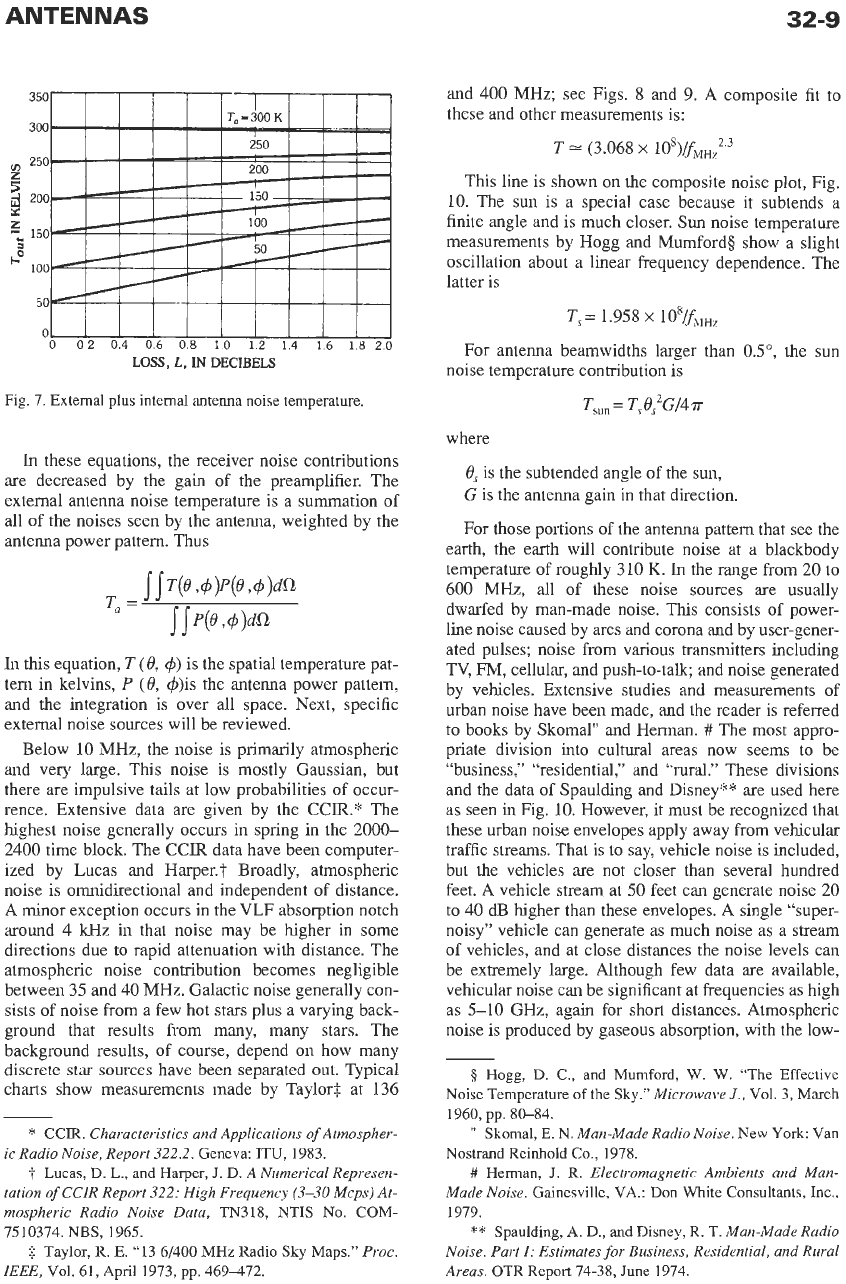
ANTENNAS
100-
50
0,
32-9
’
’
’/+-
’
’
’ ’
//
Fig. 7. External
plus
internal antenna noise temperature.
In
these equations, the receiver noise contributions
are decreased by the gain of the preamplifier. The
external antenna noise temperature is a summation
of
all of the noises seen by the antenna, weighted by the
antenna power pattern. Thus
JJqe
>@(e
d)dO
J
JP(0
>4
)do
T,
=
In this equation,
7‘
(0,
4)
is the spatial temperature pat-
tern in kelvins,
P
(0,
$)is the antenna power pattern,
and the integration is over all space. Next, specific
external noise sources will be reviewed.
Below
10
MHz, the noise is primarily atmospheric
and very large. This noise is mostly Gaussian, but
there are impulsive tails at low probabilities of occur-
rence. Extensive data are given by the
CCIR.”
The
highest noise generally occurs in spring in the 2000-
2400 time block. The
CCIR
data have been computer-
ized by Lucas and Harper.t Broadly, atmospheric
noise is omnidirectional and independent of distance.
A minor exception occurs in the VLF absorption notch
around 4
kHz
in that noise may be higher in some
directions due to rapid attenuation with distance. The
atmospheric noise contribution becomes negligible
between 35 and 40 MHz. Galactic noise generally con-
sists of noise from a few hot stars plus a varying back-
ground that results from many, many stars. The
background results, of course, depend on how many
discrete
star
sources have been separated out. Typical
charts show measurements made by Taylor$ at 136
*
CCIR.
Characteristics and Applications
of
Atmospher-
ic Radio Noise, Report 322.2.
Geneva:
ITU,
1983.
7
Lucas,
D.
L.,
and
Harper,
J.
D.
A Numerical Represen-
tation
of
CUR Report 322: High Frequency (3-30 Mcps)
At-
mospheric Radio Noise Data,
TN318,
NTIS
No. COM-
7510374. NBS, 1965.
$
Taylor, R. E. “13 6/400 MHz Radio
Sky
Maps.”
Proc.
IEEE,
Val.
61,
April 1973, pp. 469472.
and
400
MHz; see Figs.
8
and
9.
A composite fit
to
these and other measurements is:
T
=
(3.068
x
108)&M,>3
This line is shown on the composite noise plot, Fig.
10.
The sun is a special case because it subtends a
finite angle and is much closer. Sun noise temperature
measurements by Hogg and Mumfords show a slight
oscillation about a linear frequency dependence. The
latter is
TI=
1.958
X
108/f,,,
For antenna beamwidths larger than
OS”,
the sun
noise temperature contribution is
T,,,
=
TJ0;Gf4.r
where
0,
is the subtended angle of the sun,
G
is the antenna gain in that direction.
For those portions of the antenna pattern that see the
earth, the earth will contribute noise at a blackbody
temperature of roughly 310
K.
In
the
range from 20 to
600 MHz, all of these noise sources are usually
dwarfed by man-made noise. This consists of power-
line noise caused by arcs and corona and by user-gener-
ated pulses; noise from various transmitters including
TV,
FM,
cellular, and push-to-talk, and noise generated
by vehicles. Extensive studies and measurements of
urban noise have been made, and the reader
is
referred
to books by Skomal” and Herman.
#
The most appro-
priate division into cultural areas now seems to be
“business,” “residential,” and “rural.” These divisions
and the data
of
Spaulding and Disney”” are used here
as seen
in
Fig.
10.
However, it must be recognized that
these urban noise envelopes apply away from vehicular
traffic streams. That is to say, vehicle noise is included,
but the vehicles
are
not closer than several hundred
feet. A vehicle stream at
50
feet can generate noise 20
to 40 dB higher than these envelopes.
A
single “super-
noisy” vehicle can generate as much noise as a stream
of vehicles, and at close distances the noise levels can
be extremely large. Although few data are available,
vehicular noise can be significant at frequencies as high
as 5-10 GHz, again for
short
distances. Atmospheric
noise is produced by gaseous absorption, with the low-
§
Hogg,
D.
C., and
Mumford,
W.
W.
“The
Effective
Noise
Temperature
of
the
Sky.”
Microwave
J.,
Val.
3,
March
1960, pp. 80-84.
“
Skomal,
E.
N.
Man-Made Radio Noise.
New
York: Van
Nostrand
Reinhold
Co., 1978.
#
Herman,
J.
R.
Electromagnetic Ambients and Man-
Made Noise.
Gainesville, VA.:
Don
White
Consultants, Inc.,
1979.
**
Spaulding, A. D., and Disney, R.
T.
Man-Made Radio
Noise. Part I: Estimates for Business, Residential, and Rural
Areas.
OTR
Report 74-38,
June
1974.
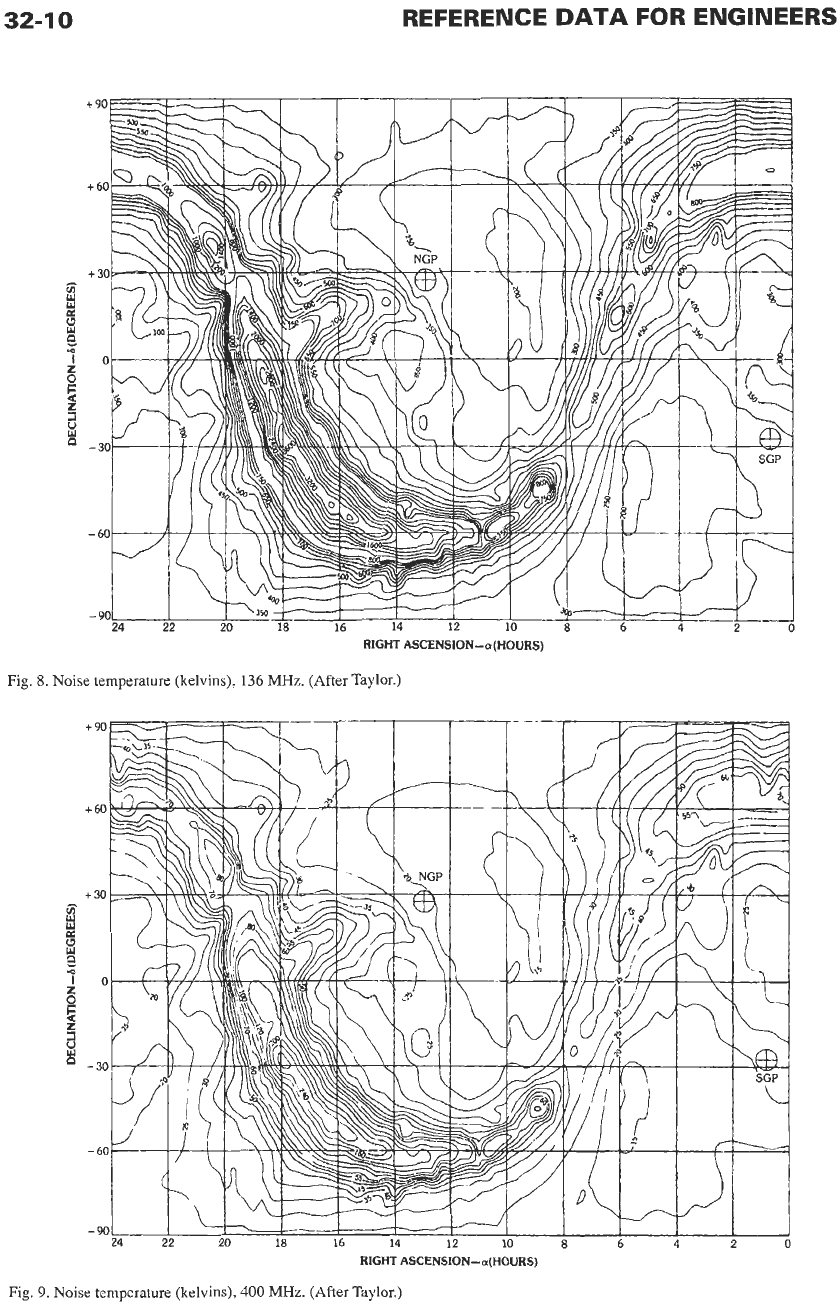
32-1
0
REFERENCE
DATA
FOR ENGINEERS
RIGHT ASCENSION-a(H0URS)
Fig.
8.
Noise temperature (kelvins),
136
MHz.
(After
Taylor.)
RIGHT ASCENSION--u(HOURS)
Fig.
9.
Noise temperature (kelvins),
400
MHz.
(After Taylor.)
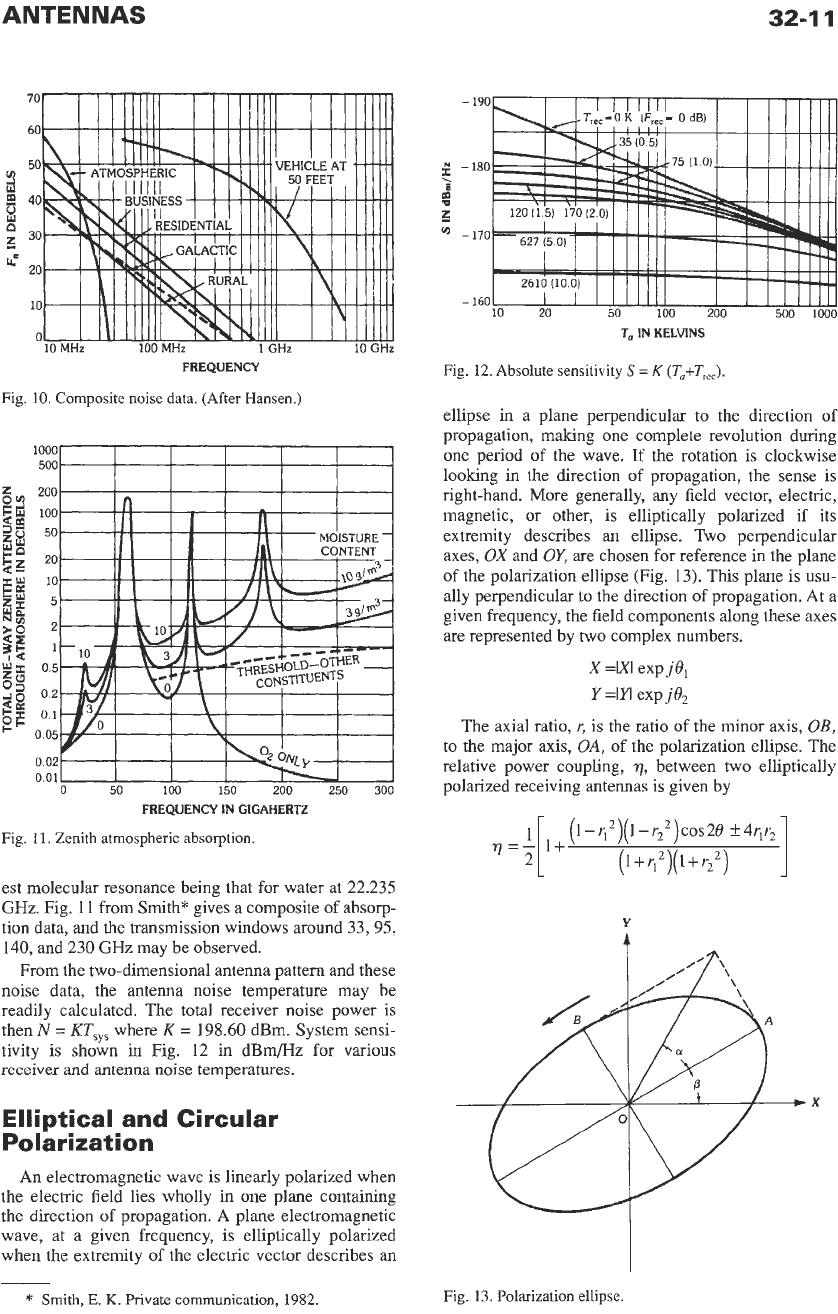
ANTENNAS
32-1
1
FREQUENCY
Fig.
10.
Composite noise data. (After
Hansen.)
200
100
50
20
10
5
2
1
0.5
0.2
0.1
0 05
0.02
0.01
0
50
100
150
200
250
300
FREQUENCY
IN
GIGAHERTZ
Fig.
11.
Zenith atmospheric absorption.
est molecular resonance being that for water at 22.235
GHz. Fig. 11 from Smith* gives a composite
of
absorp-
tion data, and the transmission windows around 33,95,
140,
and 230 GHz may be observed.
From the two-dimensional antenna pattern and these
noise data, the antenna noise temperature may be
readily calculated. The total receiver noise power is
then
N
=
KTsys
where
K
=
198.60 dBm. System sensi-
tivity is shown
in
Fig. 12 in dBm/Hz for various
receiver and antenna noise temperatures.
Elliptical and Circular
Polarization
An electromagnetic wave is linearly polarized when
the electric field lies wholly in one plane containing
the direction of propagation. A plane electromagnetic
wave, at a given frequency, is elliptically polarized
when the extremity of the electric vector describes an
F
0
b
v1
190
180
170
160
10
20
50
100
200
500
1000
Ta
IN KELVINS
Fig.
12.
Absolute sensitivity
S
=
K
(Ta+Trec).
ellipse in
a
plane perpendicular to the direction
of
propagation, making one complete revolution during
one period of the wave. If the rotation is clockwise
looking in the direction
of
propagation, the sense is
right-hand. More generally, any field vector, electric,
magnetic, or other, is elliptically polarized if its
extremity describes an ellipse. Two perpendicular
axes,
OX
and
OY,
are chosen for reference in the plane
of the polarization ellipse (Fig. 13).
This
plane is
usu-
ally perpendicular to the direction of propagation. At a
given frequency, the field components along these axes
are represented by two complex numbers.
X
=KI
expjOl
Y
=IM
expjO,
The axial ratio,
u,
is the ratio of the minor axis,
OB,
to the major axis,
OA,
of the polarization ellipse. The
relative power coupling,
17,
between two elliptically
polarized receiving antennas is given by
1
(l-u12)(1-u22)c0s28
+4u1r,
(1
+
$)(
1
+
$)
Y
A
*
Smith,
E.
K.
Private communication,
1982.
Fig.
13.
Polarization ellipse.

32-1
2
REFERENCE
DATA
FOR ENGINEERS
In
this equation,
r1
and
r,
are
the axial ratios of the
antennas, and
0
is the angle between the major axes of
the polarization ellipses. The plus sign is used if both
antennas produce the same sense of polarization, and
the
minus sign is used for opposite senses.” When a
typical circularly polarized antenna
is
measured by a
perfect rotating linear antenna, the circularly polarized
gain
is
calculated from
Gcir
=
[.\ii~
+dGz]2
Figs.
14
and
15
show transmission efficiency from
a
nearly linear antenna to a nearly circular antenna for
both senses of polarization and for both zero and
90-
degree orientation. When antenna gain is measured
with a nominally linear standard-gain antenna where
the orthogonal powers for two linear polarizations are
summed, there is an error if the standard-gain antennas
are imperfect. If the antenna under test has axial ratio
r1
and the standard-gain antenna has axial ratio
r,,
the
error in gain measurement is as follows:
Error=
1
*4r1r2/(1
+rI2)(1
+r:)
Figs.
16
and
17
show these errors for same sense
and opposite sense
of
polarization.
ANTENNA
1
AXIAL RATIO IN DECIBELS
Fig. 15. Near-linear
to
near-circular efficiency. orientation
90.
(Courtesy
J.
J.
Murphy, Aerospace Corp.)
ANTENNA
1
AXIAL RATIO IN DECIBELS
Fig.
14. Near-linear to near-circular efficiency, orientation
0.
(Courtesy
J.
J.
Murphy, Aerospace Corp.)
*
Hatkin,
L.
“Elliptically Polarized Waves.”
Proc.
IRE,
Vol.
38,
December
1950,
p.
1455.
ANTENNA
1
AXIAL RATIO
IN
DECIBELS
Fig.
16.
Error in
gain
measurement,
same
sense.
(Courtesy
J.
J.
Murphy, Aerospace Corp.)
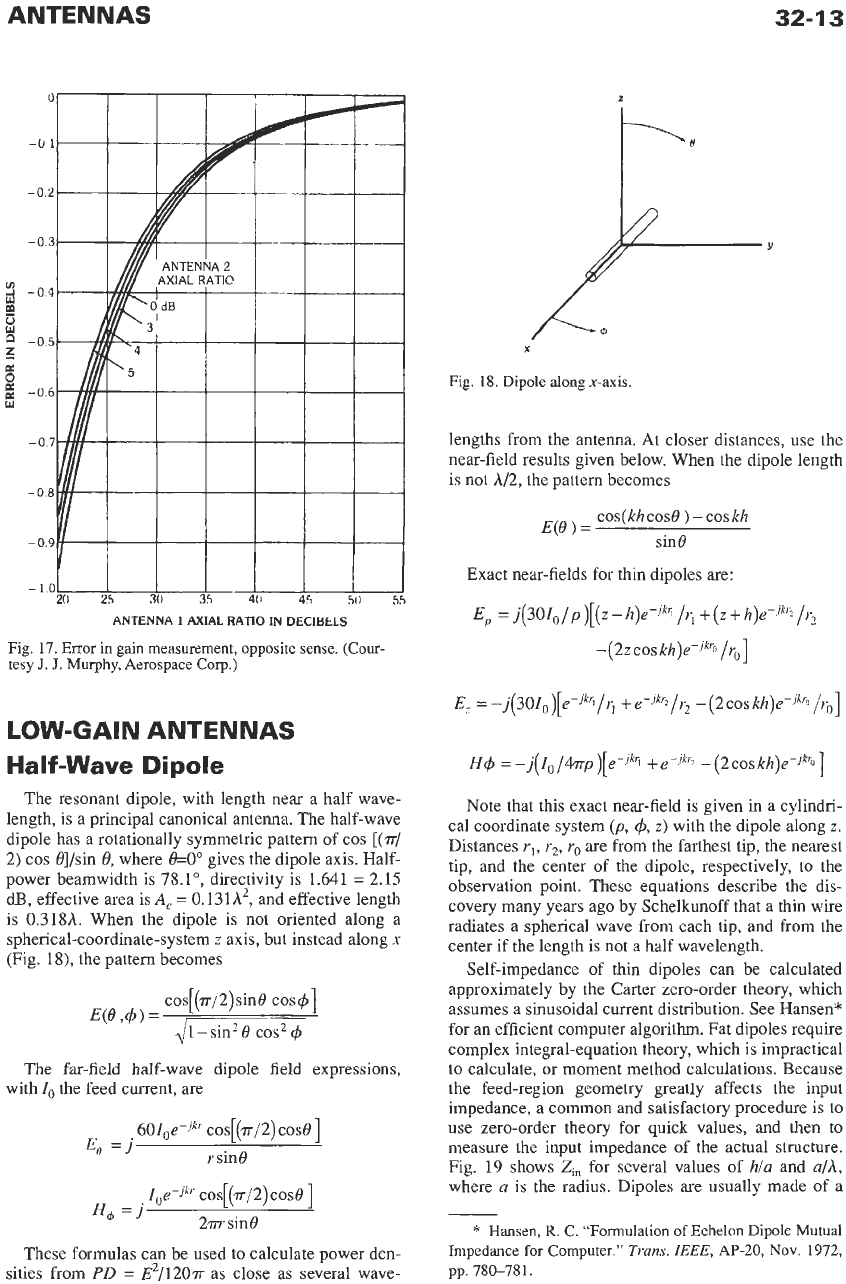
ANTENNAS
X
Fig.
18.
Dipole along x-axis.
32-1
3
2
ANTENNA
1
AXIAL RATIO IN
DEClBtLS
Fig.
17.
Error
in gain measurement, opposite sense.
(Cour-
tesy
J.
J.
Murphy,
Aerospace
Corp.)
LOW-GAIN ANTENNAS
Half-Wave Dipole
The resonant dipole, with length near a half wave-
length, is a principal canonical antenna. The half-wave
dipole has a rotationally symmetric pattern of cos
[(T/
2) cos O]/sin
13,
where
&O”
gives the dipole axis. Half-
power beamwidth
is
78.1”, directivity is 1.641
=
2.15
dl3,
effective area is
A,
=
0.131h2, and effective length
is 0.318h. When the dipole is not oriented along a
spherical-coordinate-system
z
axis,
but
instead along
x
(Fig. 18), the pattern becomes
cos[(.rr/2)sin0 cos+]
4-
E(@
$4)
=
The far-field half-wave dipole field expressions,
with
Io
the feed current,
are
60Zoe-’kr
COS[(T~/~)COS~
]
r
sin0
Ioe-jkr
COS[(V/~)COSO
]
2nr sin8
Eo
=j
H,=j
These formulas can be used to calculate power den-
sities from
PD
=
E2/1205- as close as several wave-
lengths from the antenna.
At
closer distances, use the
near-field results given below. When the dipole length
is not h/2, the pattern becomes
cos(khcose
)
-
coskh
sine
E(O
)
=
Exact near-fields for thin dipoles
are:
Note that this exact near-field is given
in
a cylindri-
cal coordinate system
(p,
4,
z) with the dipole along
z.
Distances
rl,
r2,
ro
are from the farthest tip, the nearest
tip, and the center of the dipole, respectively,
to
the
observation point. These equations describe the dis-
covery many years ago by Schelkunoff that a thin wire
radiates a spherical wave from each tip, and from the
center if
the
length is not a half wavelength.
Self-impedance of thin dipoles can be calculated
approximately by the Carter zero-order theory, which
assumes a sinusoidal current distribution. See Hansen*
for
an
efficient computer algorithm. Fat dipoles require
complex integral-equation theory, which is impractical
to calculate,
or
moment method calculations. Because
the feed-region geometry greatly affects the input
impedance, a common and satisfactory procedure
is
to
use zero-order theory for quick values, and then to
measure the input impedance of the actual structure.
Fig.
19
shows
Zi,
for several values of
hla
and
u/h,
where
a
is the radius. Dipoles
are
usually made of a
*
Hansen,
R. C.
“Formulation
of
Echelon Dipole
Mutual
Impedance
for
Computer.”
Trans.
IEEE,
AI-20,
Nov.
1972,
pp.
780-78
1.
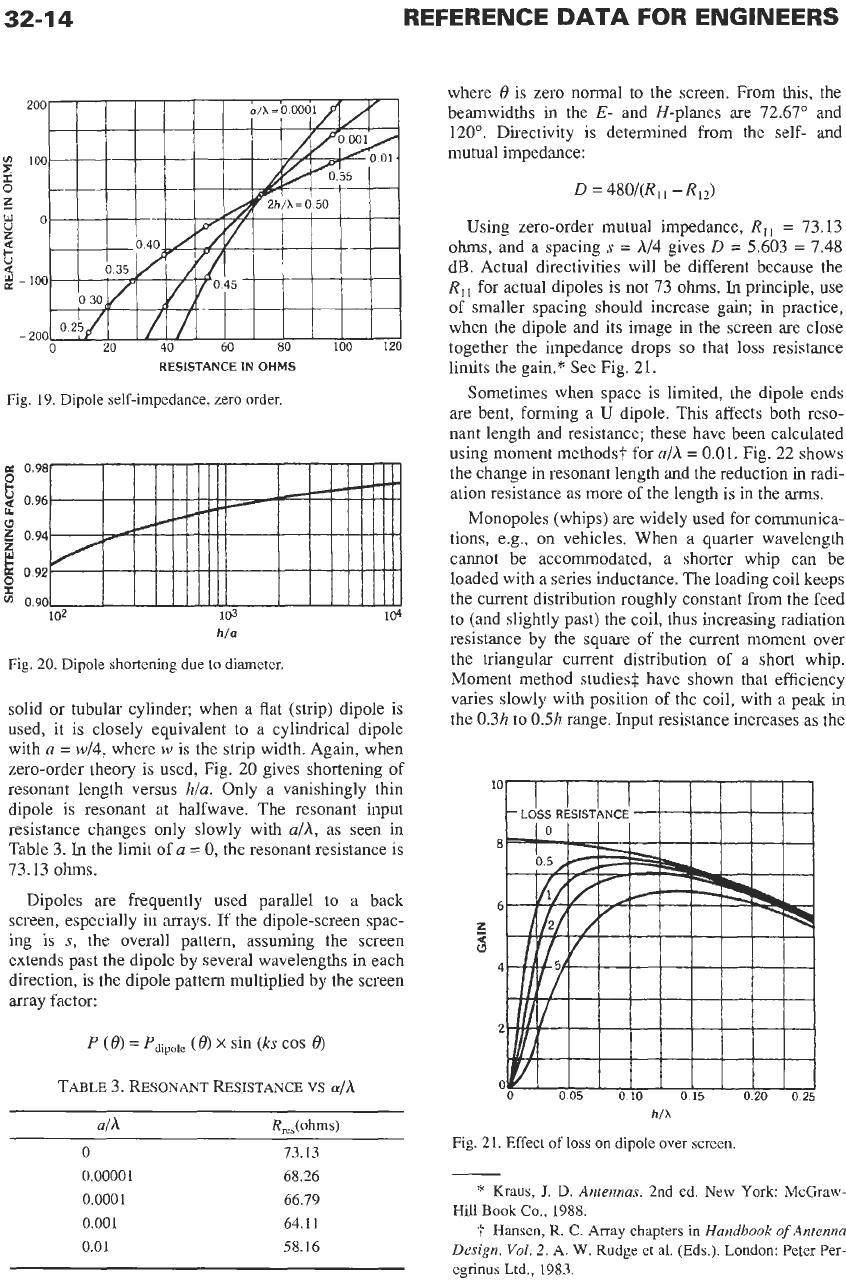
32-1
4
REFERENCE
DATA
FOR ENGINEERS
RESISTANCE
IN
OHMS
Fig.
19.
Dipole self-impedance, zero order.
8
0.98
0.96
(1
E
0.94
z
*
0.90
102
103
hla
Fig.
20.
Dipole shortening due to diameter.
104
solid or tubular cylinder; when a flat (strip) dipole is
used, it is closely equivalent to a cylindrical dipole
with
a
=
w/4, where
w
is the strip width. Again, when
zero-order theory is used, Fig. 20 gives shortening of
resonant length versus
hia.
Only a vanishingly thin
dipole is resonant at halfwave. The resonant input
resistance changes only slowly with
a/A,
as seen in
Table 3. In the limit of
a
=
0,
the resonant resistance is
73.13
ohms.
Dipoles are frequently used parallel to a back
screen, especially in arrays. If the dipole-screen spac-
ing
is
s,
the overall pattern, assuming the screen
extends past the dipole by several wavelengths in each
direction, is the dipole pattern multiplied by the screen
array factor:
P
(0)
=
Pdipole
(0)
x
sin
(ks
cos
0)
TABLE
3.
RESONANT
RESISTANCE
vs
@/A
0 73.13
0.00001 68.26
0.0001 66.79
0.001 64.11
0.01
58.16
where
0
is zero normal to the screen. From this, the
beamwidths in the
E-
and H-planes are 72.67' and
120". Directivity is determined from the self- and
mutual impedance:
D
=480/(R,1
-RlJ
Using zero-order mutual impedance,
R,,
=
73.13
ohms,
and a spacing
s
=
AI4
gives
D
=
5.603
=
7.48
dB.
Actual directivities will be different because the
R,,
for actual dipoles is not 73
ohms.
In principle, use
of smaller spacing should increase gain; in practice,
when the dipole and its image in the screen are close
together the impedance drops
so
that loss resistance
limits the gain." See Fig. 21.
Sometimes when space is limited, the dipole ends
are
bent, forming a
U
dipole. This affects both reso-
nant length and resistance; these have been calculated
using moment methods? for
alA
=
0.01.
Fig. 22 shows
the change in resonant length and the reduction in radi-
ation resistance as more of the length is in the
arms.
Monopoles (whips) are widely used for communica-
tions, e.g., on vehicles. When a quarter wavelength
cannot be accommodated,
a
shorter whip can be
loaded with a series inductance. The loading coil keeps
the current distribution roughly constant from the feed
to (and slightly past) the coil, thus increasing radiation
resistance by the square of the current moment over
the triangular current distribution
of
a
short whip.
Moment method studies4 have shown that efficiency
varies slowly with position of the coil, with a peak in
the 0.3h to
0%
range. Input resistance increases as the
z
d
0
005
0
10
0
15
0
20
0
25
h/X
Fig.
21.
Effect of
loss
on dipole
over
screen.
*
Kraus,
J.
D.
Antennas.
2nd ed. New York: McGraw-
Hill
Book
Co.,
1988.
t
Hansen,
R. C.
Array chapters in
Handbook
of
Antenna
Design,
Vol.
2.
A.
W.
Rudge et al. (Eds.). London: Peter Per-
egrinus Ltd.,
1983.
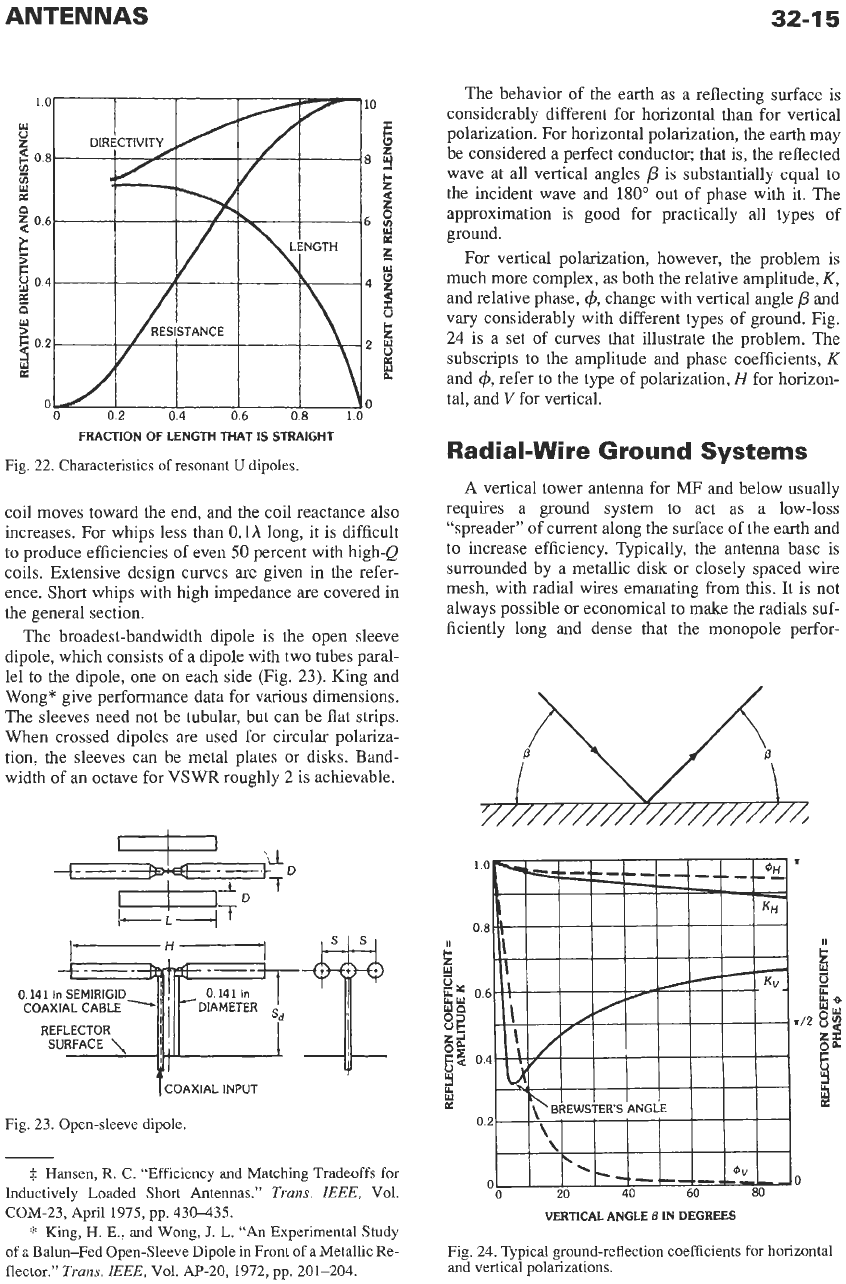
ANTENNAS
32-1
5
0
02
04
06
0.8
10
FRACTION
OF
LENGTH THAT
IS
STRAIGHT
Fig. 22. Characteristics of resonant
U
dipoles.
coil moves toward the end, and the coil reactance also
increases. For whips less than
O.lh
long, it is difficult
to produce efficiencies of even
50
percent with high-&
coils. Extensive design curves
are
given in the refer-
ence. Short whips with high impedance are covered
in
the general section.
The broadest-bandwidth dipole is the open sleeve
dipole, which consists of a dipole with two tubes paral-
lel
to
the dipole, one on each side (Fig.
23).
King and
Wong* give performance data for various dimensions.
The sleeves need not be tubular, but can be flat strips.
When crossed dipoles are used for circular polariza-
tion, the sleeves can be metal plates or disks. Band-
width of an octave for
VSWR
roughly
2
is achievable.
DIAMETER
REFLECTOR
T
I
COAXIAL
INPUT
Fig. 23. Open-sleeve dipole.
$
Hansen, R. C. “Efficiency and Matching Tradeoffs for
Inductively Loaded Short Antennas.”
Tvans.
IEEE,
Vol.
COM-23, April 1975, pp. 430435.
*
King, H. E., and Wong,
J.
L.
“An
Experimental Study
of
a
Balun-Fed Open-Sleeve Dipole in Front of a Metallic Re-
flector.”
Trans.
IEEE,
Vol. AP-20, 1972, pp. 201-204.
The behavior of the earth as a reflecting surface is
considerably different for horizontal than for vertical
polarization. For horizontal polarization, the earth may
be considered a perfect conductor; that is, the reflected
wave at all vertical angles
p
is substantially equal to
the incident wave and
180”
out
of phase with it. The
approximation is good for practically
all
types of
ground.
For vertical polarization, however, the problem is
much more complex, as both the relative amplitude,
K,
and relative phase,
4,
change with vertical angle
p
and
vary considerably with different types of ground. Fig.
24
is a set of curves that illustrate the problem. The
subscripts to the amplitude and phase coefficients,
K
and
4,
refer to the type of polarization,
H
for horizon-
tal, and
V
for vertical.
Radial-Wire Ground Systems
A
vertical tower antenna for
MF
and below usually
requires a ground system to act as a low-loss
“spreader” of current along the surface of the earth and
to increase efficiency. Typically, the antenna base
is
surrounded by a metallic disk or closely spaced wire
mesh, with radial wires emanating from this.
It
is not
always possible or economical
to
make the radials suf-
ficiently long and dense that the monopole perfor-
T
r/2
0
VERTICAL ANGLE
P
IN DEGREES
11
Fig. 24. Typical ground-reflection coefficients for horizontal
and vertical polarizations.
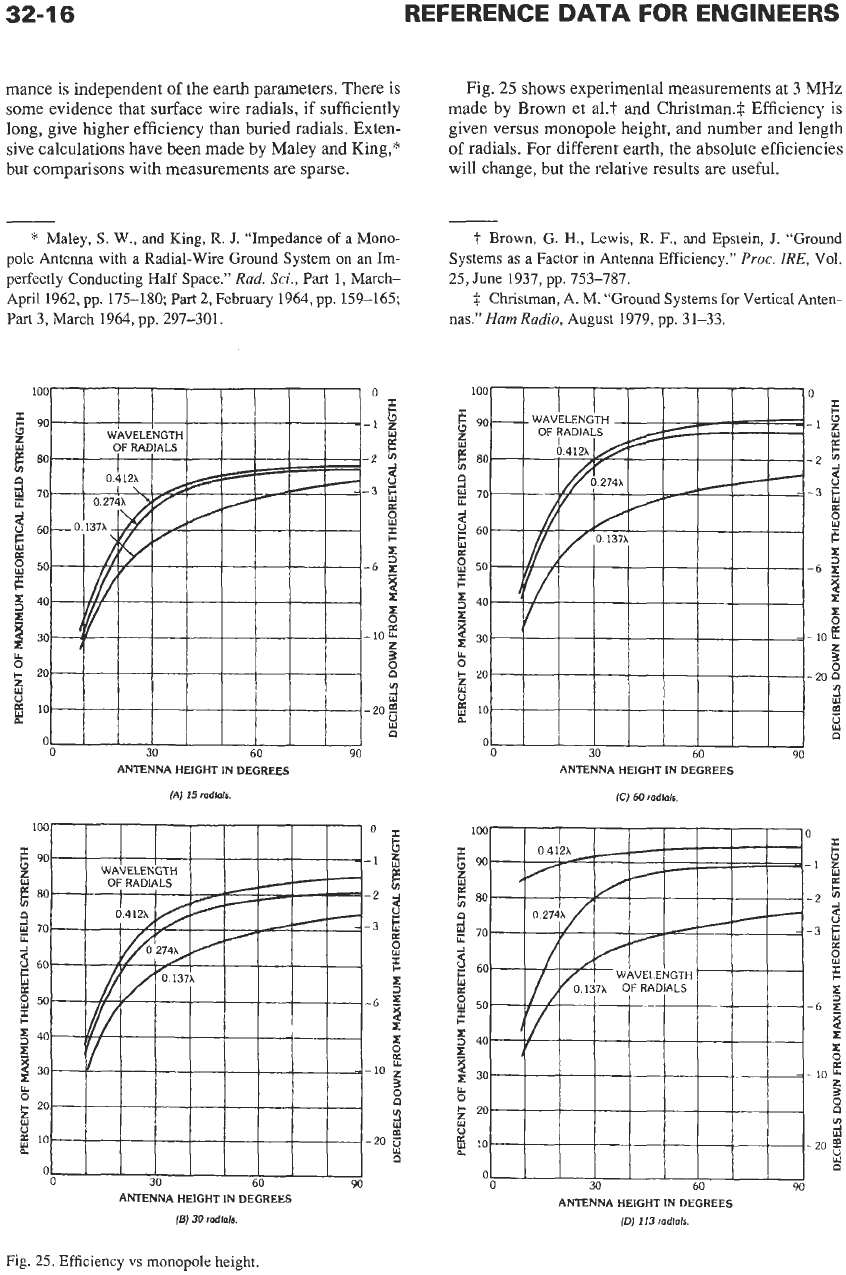
32-1
6
REFERENCE
DATA
FOR ENGINEERS
mance is independent of the earth parameters. There is
some evidence that surface wire radials, if sufficiently
long, give higher efficiency than buried radials. Exten-
sive calculations have been made by Maley and King,*
but comparisons with measurements
are
sparse.
Fig.
25
shows experimental measurements at 3
MHz
made by Brown et a1.t and Christman.$ Efficiency is
given versus monopole height, and number and length
of
radials.
For
different earth, the absolute efficiencies
will change, but the relative results are useful.
*
Maley,
S.
W., and King,
R.
J.
“Impedance of a Mono-
pole Antenna with a Radial-Wire Ground System
on
an Im-
perfectly Conducting Half Space.” Rad.
Sa.,
Part
1,
March-
April 1962, pp. 175-180;
Part
2, February 1964, pp. 159-165;
Part
3, March 1964, pp. 297-301.
t
Brown, G.
H.,
Lewis,
R.
F.,
and Epstein,
J.
“Ground
Systems
as
a Factor in Antenna Efficiency.”
Proc.
IRE, Vol.
25, June 1937, pp. 753-787.
$
Christman, A. M.
“Ground
Systems for Vertical
Anten-
nas.”Ham Radio, August 1979, pp. 31-33.
ANTENNA HEIGHT IN DEGREES
(A)
15
mdlals.
ANTENNA HEIGHT IN DEGREES
(0)
113
radlols.
Fig.
25. Efficiency
vs
monopole height.
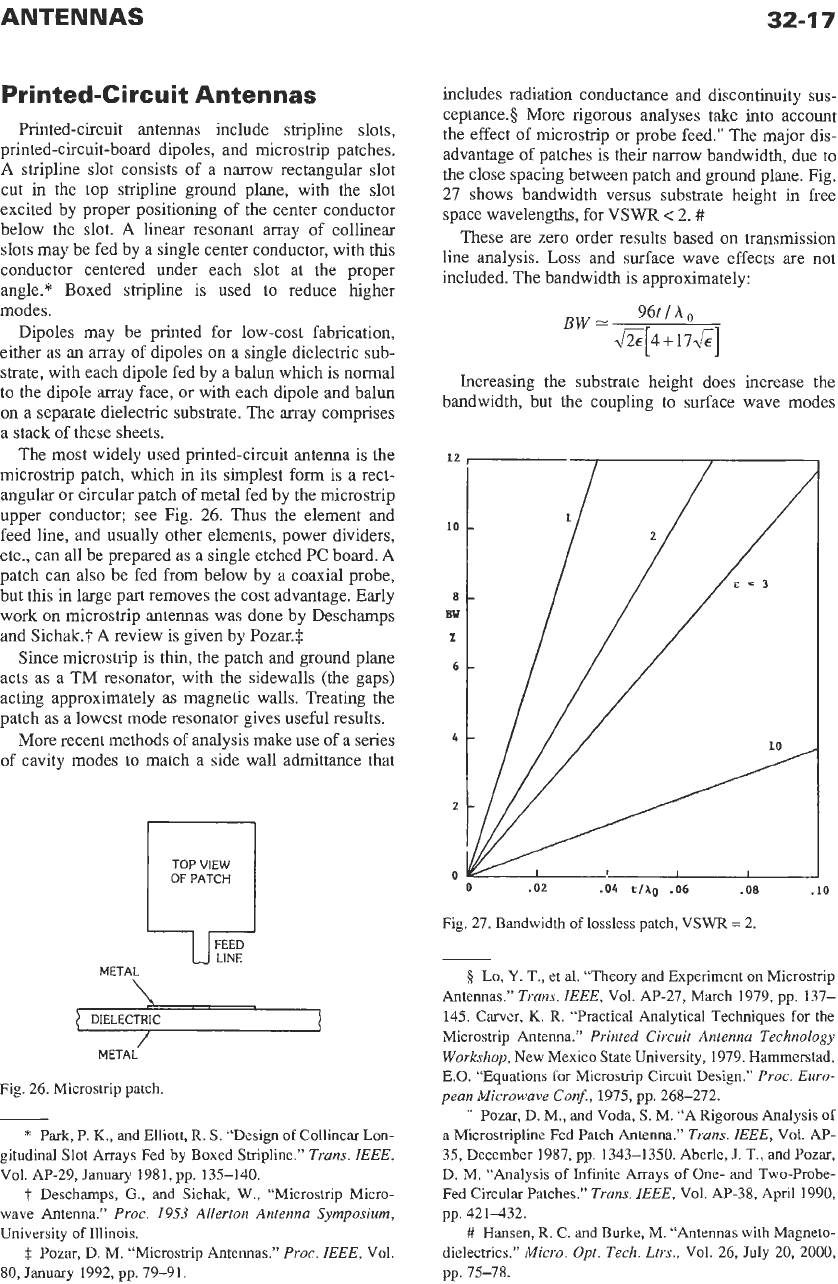
Printed-Circuit Antennas
Printed-circuit antennas include stripline slots,
printed-circuit-board dipoles, and microstrip patches.
A
stripline slot consists of a narrow rectangular slot
cut in the top stripline ground plane, with the slot
excited by proper positioning of the center conductor
below the slot.
A
linear resonant array of collinear
slots may be fed by a single center conductor, with
this
conductor centered under each slot at the proper
angle.* Boxed stripline is used
to
reduce higher
modes.
Dipoles may be printed for low-cost fabrication,
either as an array of dipoles
on
a single dielectric sub-
strate, with each dipole fed by a balun which is normal
to the dipole array face, or with each dipole and balun
on a separate dielectric substrate. The array comprises
a stack of these sheets.
The most widely used printed-circuit antenna is the
microstrip patch, which in its simplest form is a rect-
angular or circular patch of metal fed by the microstrip
upper conductor; see Fig.
26.
Thus
the element and
feed line, and usually other elements, power dividers,
etc., can all be prepared as a single etched PC board.
A
patch can also be fed from below by a coaxial probe,
but this in large part removes the cost advantage. Early
work on microstrip antennas was done by Deschamps
and Sichak.?
A
review is given by P0zar.i:
Since microstrip is thin, the patch and ground plane
acts as
a
TM resonator, with the sidewalls (the gaps)
acting approximately as magnetic walls. Treating the
patch as
a
lowest mode resonator gives useful results.
More recent methods of analysis make use of a series
of cavity modes to match a side wall admittance that
r-l
TOP
VIEW
\
1
DIELECTRIC
/
METAL
Fig. 26. Microstrip patch.
*
Park, P.
K.,
and Elliott, R.
S.
“Design of Collinear Lon-
gitudinal Slot Arrays Fed by Boxed Stripline.”
Trans. IEEE,
7
Descbamps,
G.,
and Sichak,
W.,
“Microstrip Micro-
wave Antenna.”
Proc.
I953
Allerton Antenna Symposium,
University
of
Illinois.
$
Pozar, D. M. “Microstrip Antennas.”
Proc. IEEE,
Vol.
80,
January
1992, pp. 79-91.
Vol. AP-29, Janua~y 1981, pp. 135-140.
includes radiation conductance and discontinuity
sus-
ceptance.§ More rigorous analyses take into account
the effect of microstrip or probe feed.” The major dis-
advantage of patches is their narrow bandwidth, due
to
the close spacing between patch and ground plane. Fig.
27 shows bandwidth versus substrate height in free
space wavelengths, for VSWR
<
2.
#
These
are
zero order results based on transmission
line analysis.
Loss
and surface wave effects are
not
included. The bandwidth is approximately:
96tlh,
&[4
+
17&]
BW=
Increasing the substrate height does increase the
bandwidth, but the coupling to surface wave modes
12
10
8
BY
Z
6
4
2
10
0
Fig. 27. Bandwidth of
lossless
patch, VSWR
=
2.
0
Lo,
Y.
T.,
et
al.
“Theory and Experiment
on
Microstrip
Antennas.”
Trans. IEEE,
Vol.
AP-27, March 1979, pp. 137-
145. Carver,
K.
R. “Practical Analytical Techniques for the
Microstrip Antenna.”
Printed Circuit Antenna Technology
Workshop,
New Mexico State University, 1979. Hammerstad,
E.O.
“Equations for Microstrip Circuit Design.”
Proc. Euro-
pean Microwave Conf.,
1975, pp. 268-272.
”
Pozar,
D.
M., and Voda,
S.
M. “A Rigorous Analysis of
a Microstripline
Fed
Patch Antenna.”
Trans. IEEE,
Vol. AP-
35, December 1987, pp. 1343-1350. Aberle,
J.
T.,
and Pozar,
D. M. “Analysis of Infinite Arrays of One- and Two-Probe-
Fed Circular Patches.”
Trans. IEEE,
Vol. AF-38, April 1990,
pp. 421-432.
#
Hansen,
R.
C. and
Burke,
M. “Antennas with Magneto-
dielectrics.”
Micro. Opt. Tech. Ltrs.,
Vol. 26, July
20,
2000,
pp. 75-78.
